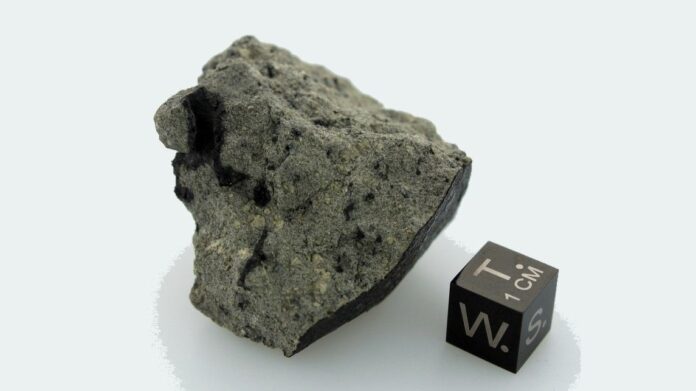A Martian meteorite that crashed in Morocco 11 years ago contains a vast diversity of organic compounds, which could help researchers discover if Mars could have hosted life and provide important clues about Earth’s geological history.
“Mars and Earth share many aspects of their evolution, and while life arose and thrived on our home planet, the question of whether it ever existed on Mars is a very hot research topic that requires deeper knowledge of our neighboring planet’s water, organic molecules, and reactive surfaces,” Philippe Schmitt-Kopplin, of the Technical University of Munich and Helmholtz Zentrum Munich in Germany, said in a statement.
The meteorite, named Tissint after the town in Morocco where it was found, is just one of five Martian meteorites that have been observed as they’ve fallen to Earth. The rock was formed hundreds of millions of years ago on Mars and was probably launched into space by an explosively violent event before falling to the surface of our planet.
Related: Infamous Mars meteorite contains organic molecules, but they aren’t proof of life
Organic compounds are large molecules that contain predominantly carbon, hydrogen, oxygen, nitrogen and sulfur. Though they are associated with life and biological processes, organic compounds can be created by nonbiological processes, too. Scientists call this “abiotic organic chemistry,” and it means that finding organic compounds doesn’t immediately point to the existence of life.
“Understanding the processes and sequence of events that shaped this rich organic bounty will reveal new details about Mars’ habitability and potentially about the reactions that could lead to the formation of life,” Andrew Steele, a researcher at the Carnegie Institution for Science in Washington, D.C., and part of the team that analyzed Tissint, said in the statement.
By thoroughly analyzing Tissint’s organic inventory, the team built the most comprehensive catalog yet of the diversity of organic compounds found in a Martian meteorite or in a sample collected and analyzed by a Mars rover. In the process, they discovered a link between the diversity of organic molecules and their type with the specific mineralogy of a meteorite.
This finding revealed details of the processes occurring beneath the Red Planet’s mantle and crust and how these processes changed over time, particularly as they relate to abiotic organic compounds that arise as the result of interactions between Martian rock and water.
The researchers also found an abundance of organic magnesium compounds, which had not previously been seen in Mars samples. These compounds could shed light on the high-pressure, high-temperature geochemistry that shaped Mars’ deep interior. The abundance of this type of organic magnesium compound could also point to a connection between the carbon cycle on Mars and the evolution of its minerals.
The team is now looking to samples returned from the Red Planet by future missions — including Mars Sample Return, a proposed joint mission of NASA and the European Space Agency — to provide geological data about Mars. This information could vastly improve our knowledge of the formation, stability and dynamics of organic compounds in ancient Martian environments.
The team’s research was published Jan. 11 in the journal Science Advances.
Follow us on Twitter @Spacedotcom or on Facebook.

